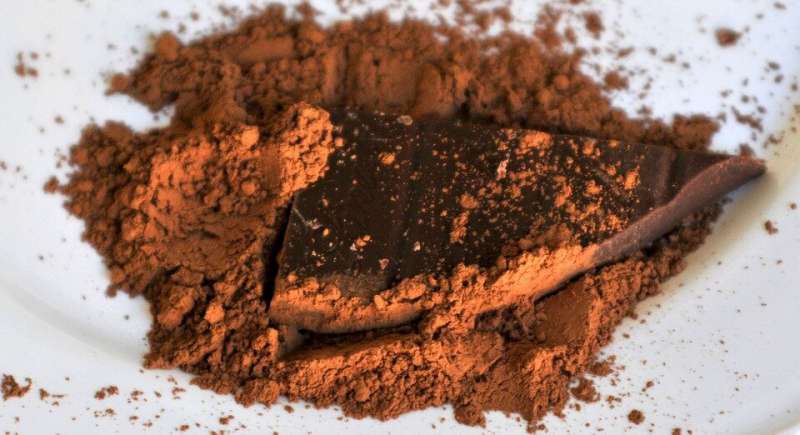Cocoa flavanols contribute to faster oxygen uptake kinetics, improved blood flow

A bioactive compound found in cocoa powder and dark chocolate could help middle-aged adults enjoy exercise, a new study has suggested. The research analyzed the potential health benefits of cocoa flavanols, a plant nutrient extracted from cocoa beans.
Cocoa flavanols are found in abundance in cocoa powder, and to a lesser extent in dark chocolate, and can be consumed as a supplement. Because cocoa flavanols have a ‘vasodilatory’ effect, helping to increase blood flow, they’ve been shown to prevent blood clots and even combat memory decline.
Now, a team of scientists from Liverpool Hope University and Liverpool John Moores University have tested the effects of cocoa flavanols when it comes to exercise in a group of sedentary adults aged between 40 and 60 years old.
And the report found that cocoa flavanols contribute to faster oxygen uptake kinetics—with improved blood flow the likely cause.
Associate Professor Simon Marwood, subject lead in sport science at Liverpool Hope University, says the findings could be important when it comes to convincing people to get off the sofa and then stick with an exercise program. He said: “One barrier to starting an exercise plan is poor fitness in the first place, perhaps because of the discomfort associated with what might otherwise be light exercise.
“Without frequent exercise, aging results in a slowing in the rate at which our oxygen consumption increases at the onset of exercise. This is due to impairments in the ability to supply blood to the exercising muscles at the onset of exercise.
“In previous studies, we have shown that this slowing of the rate of increase of oxygen consumption has a direct and inhibiting effect on the ability to tolerate exercise.
“The finding of faster increases in oxygen consumption at the onset of exercise with cocoa flavanols supplementation is therefore really encouraging for this age group since it suggests that a simple nutritional supplement can improve exercise tolerance, and therefore enhance the likelihood of sustaining an exercise program.
“This is a relatively small study but it’s encouraging and has significant results, which could be the basis for further research.”
Lead author Daniel Sadler, of Liverpool John Moores’ School of Sport and Exercise Science, concludes: “These novel effects of cocoa flavanols in this demographic may contribute to improved tolerance of moderate-activity physical activities, which appear commonly present in daily life.”
The research was published in the journal European Journal of Applied Physiology.
Professor Marwood says it’s important to note that over-consumption of chocolate, dark or otherwise, isn’t to be encouraged, although dark chocolate may contain cocoa flavanols. And the substance is most commonly available as a supplement, which is often used by amateur athletes to boost performance.
The research itself focused on a group of healthy, middle-aged men and women with an average age of 45 years old and who typically engaged in less than two hours of structured exercise training per week.
Over a period of five weeks, prior to consuming the cocoa supplement, the group was put through a series of trials, using a lab-based exercise bike, where they were incrementally pushed to exhaustion. These trials were performed in order to establish a person’s VO2 peak, the maximum amount of oxygen the body can use during exercise, as well as power output.
The test subjects were then given either a daily 400 mg cocoa flavanol supplement or a placebo over the course of seven days.
And at the end of that week, they got back on the cycle ergometers and took part in a series of step exercise tests, where they started pedaling at a baseline before the load was ramped up to either moderate or severe-intensity work rates.
The key measurement being analyzed was pulmonary VO2 kinetics, or τVO2, the time it takes for oxygen delivery to respond to the demands of exercise.
The shorter the response time, the better equipped someone is to tolerate the given exercise.
And what the research team discovered was that when the test subjects who’d consumed the cocoa flavanols were subjected to ‘moderate’ exercise, the VO2 kinetics time was ‘significantly reduced’ from around 40 seconds to 34 seconds.
This reduction of six seconds is important, the team states, because it exceeds the minimum physiologically relevant change of around 5 seconds.
The scientists add: “The reduction in τVO2 observed after cocoa flavanol supplementation in our middle-aged individuals reflects a shift toward values typically observed in younger healthy individuals.”
And the report states: “Ultimately, the findings of the present study may have clinical potential in contributing to improved tolerance of daily life activity in middle-aged adults.”
Flavonoids aren’t just found in cocoa—they’re also abundant in green tea, fruit and vegetables—and have anti-inflammatory as well as antioxidant properties.
Liverpool John Moores’ Daniel Sadler says you shouldn’t rely on eating dark chocolate to get an effective dose of flavanols.
He explains: “It is preferable to take supplements over eating dark chocolate since potential beneficial effects of cocoa flavanols occur during exercise when high doses are consumed—greater than 400 mg flavanols—and because dark chocolate contains fat and sugar that may negate the beneficial potential of any bioactive constituents.”
In April this year, a separate study by researchers at the University of Birmingham found blood vessels were able to function better during mental stress when test subjects were given a cocoa drink containing high levels of flavanols compared to when drinking a non-flavanol enriched drink.
Source: Read Full Article


